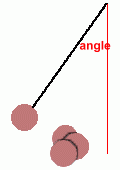
Decide what angle you will use to set the pendulum swinging. Mark it on the wall behind the release point. Set up the pendulum with a length of string, and tie one weight to the end. Leave enough extra string below the tie point so that you can attach more weights later without changing the length of string above the weight(s). Trial 1: Draw the weight back to the release point, and allow it to swing for five full periods (over and back, 5 times). Time how long it takes to do this. Then divide your answer by five, to get the time for one full period. Repeat this twice more. Don't forget to divide by five each time ... we want the time for one period. Now average your three answers. If you have printed this page, record your answer here: Trial 2: Add a weight, so that two are tied to the string. Don't change the length of string above the weight(s). Draw the weights back to the release point, and allow them to swing for five full periods (over and back, 5 times). Time how long it takes to do this. Then divide your answer by five, to get the time for one full period. Repeat this twice more. Don't forget to divide by five each time ... we want the time for one period. Now average your three answers. If you have printed this page, record your answer here: Trial 3: Add a weight, so that three are tied to the string. Don't change the length of string above the weight(s). Draw the weights back to the release point, and allow them to swing for five full periods (over and back, 5 times). Time how long it takes to do this. Then divide your answer by five, to get the time for one full period. Repeat this twice more. Don't forget to divide by five each time ... we want the time for one period. Now average your three answers. If you have printed this page, record your answer here: By now you should have data that will lead you to a conclusion. You might want to write your conclusion here: _________________________________________ Now try the next experiment. |
